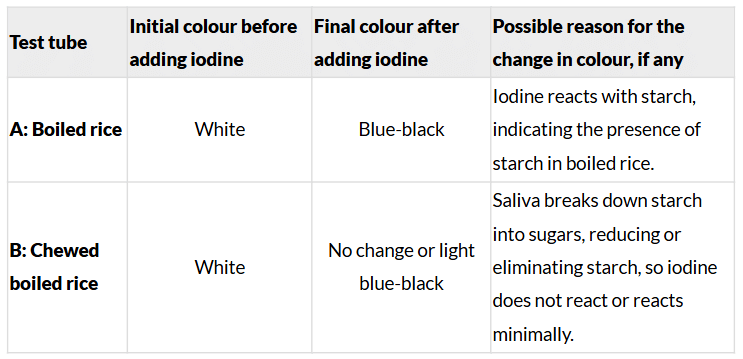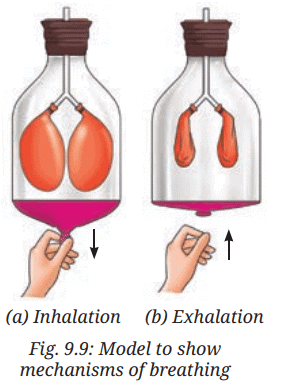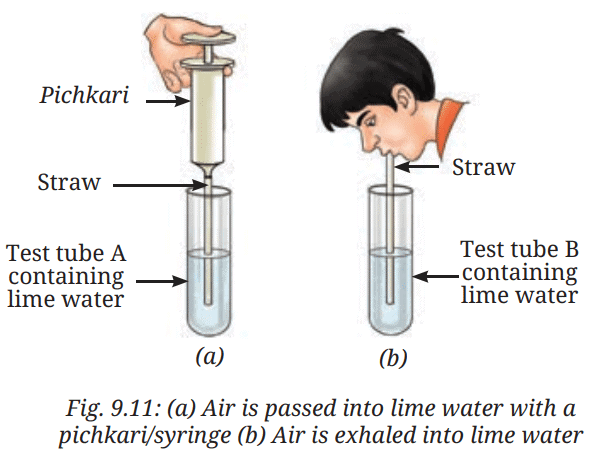Class 7 Exam > Class 7 Notes > Science (Curiosity) Class 7 - New NCERT > NCERT Based Activity: Life Processes in Animals
Class 7 Science Chapter 9 NCERT Based Activity - Life Processes in Animals
Activity 9.1: Let us investigate
Description:
- Take two test tubes and label them as 'A' and 'B'.
- Take one teaspoonful of boiled rice in test tube A, and take a teaspoonful of boiled rice after chewing it for 30-60 seconds in test tube B.
- Add 3-4 mL of water in both test tubes.
- Note the initial colour of the rice-water mixture in Table 9.1.
- Add 3-4 drops of iodine solution into each test tube with a dropper. Mix the contents and observe.
- Record observations in Table 9.1.

- If the colour still appears in test tube B, what changes would you make in the activity to explore it further? Would the colour change if chewing time is increased? Try to find out by repeating the activity.
Ans: Table 9.1: Action of saliva on starch
- If the colour still appears in test tube B (e.g., light blue-black), increase the chewing time to 60–90 seconds to allow more time for saliva to break down starch. Alternatively, ensure thorough chewing to mix saliva evenly with the rice.
- Repeating the activity with increased chewing time (e.g., 90 seconds) results in no colour change in test tube B, as more starch is converted to sugars, preventing the iodine-starch reaction.
Activity 9.2: Let us make a model
Description:
- Take a wide transparent plastic bottle with a lid and remove its bottom.
- Make a hole in the lid.
- Take a Y-shaped hollow tube.
- Fix two deflated balloons to the forked end of the tube, securing them with rubber bands to make them airtight.
- Insert the straight end of the tube through the lid from the open base of the bottle and seal the lid with clay to make it airtight.
- Attach a thin rubber sheet to the open base of the bottle tightly using a large rubber band.
- Pull the rubber sheet downwards from the centre and observe the balloons (Fig. 9.9a).
- Release the rubber sheet upwards and observe the balloons (Fig. 9.9b).
- Note what happens to the balloons during these actions.

Ans: Observation and Explanations are as follows:
Observations:
- When the rubber sheet is pulled downwards (Fig. 9.9a), the balloons inflate.
- When the rubber sheet is released upwards (Fig. 9.9b), the balloons deflate.
Explanation:
- The balloons represent the lungs, and the rubber sheet represents the diaphragm.
- Pulling the rubber sheet downwards mimics inhalation, where the diaphragm moves downwards, increasing the chest cavity space and allowing air to enter the lungs (balloons inflate).
- Releasing the rubber sheet upwards mimics exhalation, where the diaphragm moves upwards, reducing the chest cavity space and pushing air out of the lungs (balloons deflate).
Activity 9.3: Let us explore
Description:
- To be demonstrated by the teacher.
- Take an equal amount of freshly prepared lime water in two test tubes, A and B.
- In test tube A, pass air using a syringe/pichkari (Fig. 9.11a). This is the same air that is inhaled.
- In test tube B, repeatedly blow air through the mouth into the lime water using a straw (Fig. 9.11b).
- Observe any changes in the colour of the lime water.

Ans: Observation and Explanations are as follows:
Observations:
- Test tube A: The lime water remains clear (no change).
- Test tube B: The lime water turns milky or cloudy.
Explanation:
- Lime water turns milky when it reacts with carbon dioxide.
- Test tube A contains inhaled air, which has a lower concentration of carbon dioxide, so no significant reaction occurs.
- Test tube B contains exhaled air, which has a higher concentration of carbon dioxide (produced during respiration), causing the lime water to turn milky.
The document Class 7 Science Chapter 9 NCERT Based Activity - Life Processes in Animals is a part of the Class 7 Course Science (Curiosity) Class 7 - New NCERT.
All you need of Class 7 at this link: Class 7
|
80 videos|319 docs|12 tests
|
FAQs on Class 7 Science Chapter 9 NCERT Based Activity - Life Processes in Animals
| 1. What are the main life processes in animals? |  |
Ans. The main life processes in animals include nutrition, respiration, transportation, excretion, and reproduction. These processes are essential for the survival and functioning of animals, allowing them to obtain energy, remove waste, and reproduce.
| 2. How do animals obtain nutrition? |  |
Ans. Animals obtain nutrition through various means, primarily by consuming food. They may be herbivores, carnivores, or omnivores, depending on their diet. The process of digestion breaks down food into nutrients, which are then absorbed into the body for energy and growth.
| 3. What is the role of respiration in animals? |  |
Ans. Respiration is the process by which animals take in oxygen and release carbon dioxide. It occurs in the cells to convert food into energy. This energy is vital for all bodily functions, including movement, growth, and reproduction.
| 4. How do animals excrete waste? |  |
Ans. Animals excrete waste through various organs depending on their type. Most terrestrial animals use kidneys to filter and remove waste products from their blood, which are then excreted as urine. Aquatic animals may excrete waste directly into the water.
| 5. Why is reproduction important for animals? |  |
Ans. Reproduction is crucial for the survival of species. It allows for the continuation of genetic material from one generation to the next. Animals reproduce in various ways, including sexually and asexually, ensuring diversity and adaptation within populations.
Related Searches
















